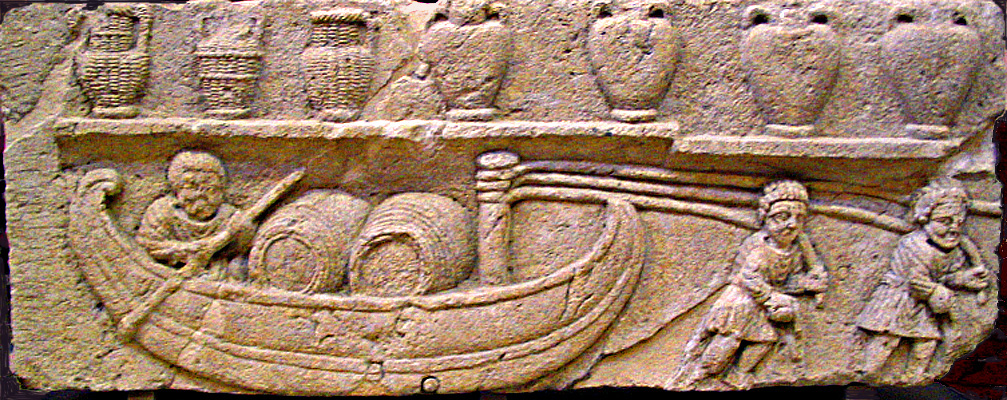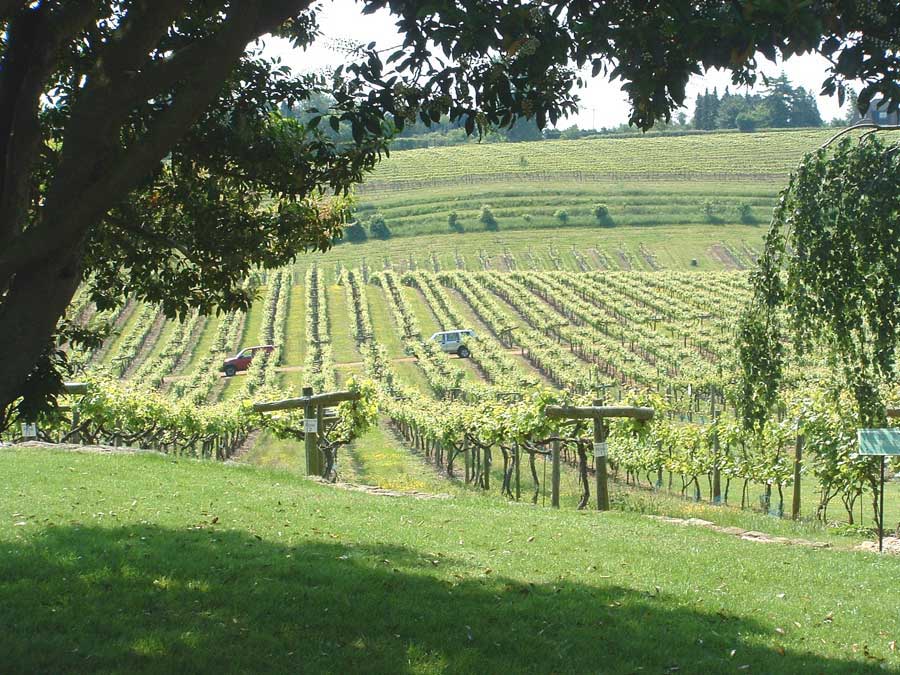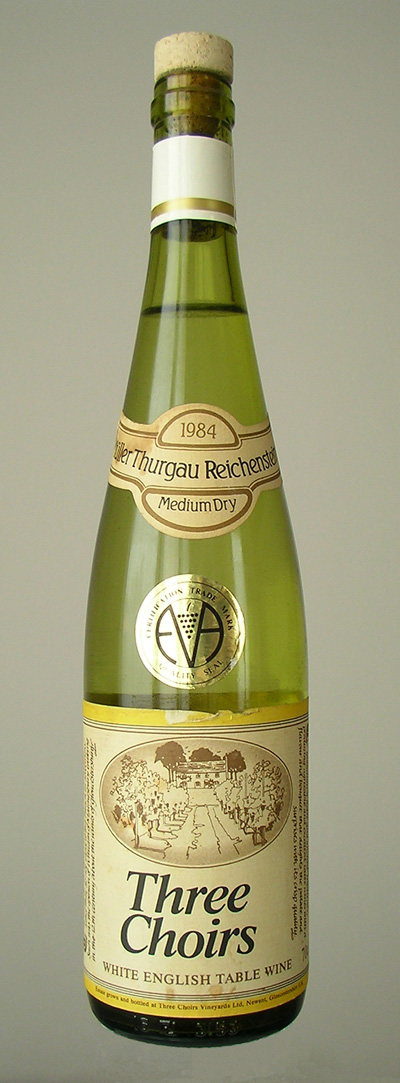English wine
From London, along the busy A 21 that winds towards Hastings, you arrive in a couple of hours, in Lamberhurst, in the heart of Kent. The area, known as the Weald, was called in ancient times Anderida forest and attracted hunters looking for deer or boar. The Eight Century deforestations spared ample patches of wood so that in some areas, where castles have stood the ravages of time, the atmosphere of an England evoked in Walter Scott novels, appears still vivid.
On the hilly landscape, stretch the fields of hops – of which the region is the biggest English producer – and of oats. Lamberhurst fits harmoniously with this landscape, and many of its houses maintain their original wood and stone facade. Its two hotels, the George & Dragon Inn and the Chequers Inn, the latter built in 1412 and the only pub in the area, offer no more than a dozen rooms but present a superb English cuisine which can be accompanied by local wines: in fact Lamberhurst boasts the biggest winemaking business in the United Kingdom. Since 1972 50 acres have been planted with vines, mostly French and German grafted root stocks.
But this is not the only viticultural business: English growers, according to a 1986 study carried out by the Ministry of Agriculture, have turned out to be 323 in number and they tend vines in a crescent moon shaped area around Grater London, in Bedforshire, Essex, Suffolk, Kent and Gloucestershire. Growers can be found even in the Thames valley. Perhaps they have aspirations of imitating the renowned German valleys, but English wines are regarded by the EEC as table wines and until now the Community has not allowed them to use the DOC seal. No wonder: the yearly production of English wine reaches only 23000 hectolitres compared to the Italian production of 70 million and the EEC’s 195 million. Great Britain, which in the last eight years has registered a 100 per cent increase in its wine consumption, while trying to become a producer, is still, above all, a big importer of French, German and Italian wines.
To produce wine in Great Britain demands a remarkable investment. Land costs around £ 1800 per acre (see note below), a further £ 1300 is required for the planting of the young vines and another £350 for their maintenance, while £1800 are needed for the trellises in the third year.
The first commercial crop, according to experts interviewed, comes in the fourth year and per acre one can rely on a production of 3.5 tons, but weather can hamper expectations. No doubts about it, English vine growers must be wealthy and very fond of this business. An example is Kenneth MacAlpine, a distinguished gentleman in his 60’s, owner of Lamberhurst vineyards. He shares the management of a family business grouping different parent companies which take care of distinct sectors of industry and commerce. When MacAlpine perceived that the entry into the EEC would cause a serious fall in farming prices, he began to look towards other crops, and the viticulture experiences of some farmers in Kent, led him to try this new field.
He went to Gesenheim agricultural Institute in Germany, carrying with him soil samples and weather records of his future vineyards. German experts told him that his vineyards stood a good chance. From then on investing in the wine business has become his favourite hobby. The English market buys all his yearly production, 700.000 bottles, partly made from grapes bought outside. However he has also exported to Japan, Singapore, Holland, Sweden and the USA before the dollar slump and the recent American taxation impositions.
For MacAlpine, ten years president of the English Vineyards Associations, the future of English wine looks good, mainly because the vines are young and in later years should yield better grapes. The real problem, according to him, are the people who produce poor quality wine who lead disappointed consumers to keep a distance from the English product. Here it has to be pointed out that the so called “English wine” is produced with home grown grapes, while the “British wine” is made from imported musts which are refermented in England, therefore it’s up to us to guess what is English about it!
But on the modern and neat MacAlpine farm in Lamberhurst, which employs 14 people all-year-round among them oenologists (wine experts), technicians and clerical personnel, it is Karl Heinz Johner, a young, dynamic German expert who supervises all the production processes in the MacAlpine farm, the protagonist. As we walk along a vineyard trail, already trampled by thousands of tourists, he talks excitedly of data and figures with enthusiasm, in perfect English which hardly betrays his Teutonic origins.
They cultivate some 30 types of vines but the bulk is composed of Muller Thurgau, a vine which alone contributes to the 28 per cent of all English production, followed by Reichensteiner, Schonburger, Seyval Blanc and Huxelrebe, the first three German, the others, French hybrids. After a number of experiments they chose the Geneva Double Curtain, an American method for training vines: the plant is left with two main trunks whose shoots are positioned manually, on galvanized wire trellis, at the height of about two yards, horizontally and opposite each other, thus benefiting from all available light.
This method was introduced for the first time in Europe by Bernard Theobald, an English farmer who in Purley, Surrey, owns a successful vineyard. “Yield per acre fluctuate on a base of 3 tons per acre, but we are subject to weather-whims and nature vexations and we have to protect the vines from rabbits using buried nets” says Karl, “Moreover because vineyards are scattered, birds are one of the most dangerous pests, but because they are protected by the law we cannot do anything but cover the whole vineyard with nets as soon as the grapes begin to ripen”.
Another problem is the wind. They have planted quick growing trees around the perimeter of the vineyards to reduce its damaging effects and inserted amongst the vines on every first row, special windbreakers made of plastic, called Paraweb. This reduces the speed of the south-west winds by 50 per cent. Boitrytis cinerea, a fungus that thrives in wet weather also attacks the vines. In these circumstances the lack of hail, which afflicts Europe’s vineyards, can be comforting. Great Britain lies in the highest part of the so called northern wine belt, a line which touches the Alsace, in France, Luxembourg, and the Rhine and Moselle valleys in Germany.
In a country where rainfall can vary between 20 inches in Cambridgeshire and up to 175 inches in certain parts of Wales, it would appear that there should be no need for the sprinkler system. But after the severe droughts of ’69, ’76 and ’83 they are being used in some English vineyards to increase the yield. “The Plant accustomed to such high rainfall does not grow deep roots and so, during dry spells, cannot reach underground water, so you need to water it if the yield is to be good “. This is Karl’s view.
English vineyards do have some advantages over European growers: Philloxera vastatrix, a dangerous aphis which destroyed all vineyards in Europe in the eighteen century, is unknown here, probably because of the climate and very low concentration of English vineyards. Must alcohol content varies from 8 to 9 degrees, a value which is augmented by adding sugar. Here too, as in Europe you can find wine in barriques – French bay oak barrels, to be precise – a good example of The European community, bearing in mind that the grapes are English and the oenologist German. “Anyway”, comments Karl, “in England, instead of metric measures, feet, acres and gallons are still in common use”.
Harvest time takes place in mid-November to take advantage of the last rays of sun. White grapes do not need scorching sun but plenty of daylight and Britain in its northerly wine belt enjoys a longer day compared to European producers. English wines are very fruity, a little sweet because of small quantities of residual sugar. They have freshness and flavour rather than full body or bouquet. The wines are steady, that is with a low alcohol content, 10-11.5 degrees, which can stand 3-4 years and are in tune with the world taste trend, wines mostly whites, demi-sec, that is, between sweet and dry. Good too is the rosé produced on the Theobald’s farm, a former boatswain who claims before a small group of visitors that the best rosé in the world is the one made in his vineyard. “Look” he says, displaying a bottle with typical English pride, “this is the first Pinot Noir ever made in England. It has been ascertained that in the last ten years world temperatures have risen one degree and it is forecast that in the year 2000 a further three degree increase. So we will have, in this beautiful Thames valley, the same temperature of the Bordeaux area”.
Harvest time takes place in mid-November to take advantage of the last rays of sun. White grapes do not need scorching sun but plenty of daylight and Britain in its northerly wine belt enjoys a longer day compared to European producers. English wines are very fruity, a little sweet because of small quantities of residual sugar. They have freshness and flavour rather than full body or bouquet. The wines are steady, that is with a low alcohol content, 10-11.5 degrees, which can stand 3-4 years and are in tune with the world taste trend, wines mostly whites, demi-sec, that is, between sweet and dry. Good too is the rosé produced on the Theobald’s farm, a former boatswain who claims before a small group of visitors that the best rosé in the world is the one made in his vineyard. “Look” he says, displaying a bottle with typical English pride, “this is the first Pinot Noir ever made in England. It has been ascertained that in the last ten years world temperatures have risen one degree and it is forecast that in the year 2000 a further three degree increase. So we will have, in this beautiful Thames valley, the same temperature of the Bordeaux area”.
Mario Maffi, the oenologist of Montelio vineyard, in Oltrepo Pavese, Northern Italy, an estate founded in 1848 and one of the few in Italy to also produce the Muller Thurgau, sums up his opinion on six English wines: “They are aromatic wines with a residual sweetness which is not always accepted by the average Italian, a velvety but not nauseous sweetness though, that would meet young people’s taste. They come close to Rhine wines. Pleasant products with ample floral scents, some wines with a better texture if compared to the others. It is a nice surprise, one must say it, especially this Three Choirs ’84, with a spiced scent, a little bitter, not particularly sweet, a little sparkly. It is the one which would be appreciated most by Italians. Also the Westbury Pinot Noir has a very delicate scent, traces of underwood fruits, a little musky, a morello back taste, a perfect balance. It is surprising that wines so well-conceived can be obtained in England”.
But the institutional acceptability seal on English wines comes from Luigi Veronelli, the most well-known Italian wine connoisseur, who has tasted a rosé, a Muller Thurgau from the Lamberhurst estate and the blended Muller Thurgau-Reichensteiner of Three Choirs, an estate in Gloucestershire. “The first two are quite good to have been produced in a country with scant oenological traditions, but they do not have a marked personality, while the blended has got a great character. It has merit – adds Veronelli – everyone knows that great Burgundy wines have to smell ‘la merde de poule’ to be judged such. Well, this wine smells like cat’s pee which confirms the exceptionality of this product. Smell of tomato leaves, of ripe pepper. It has got extremely interesting sensations. I must say it moved me”.
Italian growers do not have reason to panic. All English production totals only 3 million bottles per year and despite Theobald’s optimism on climate change, in Great Britain nobody is forecasting big productions per acre. However, one must acknowledge the devotion, the commitment and the seriousness of English producers.
Marco Probo Aurelio’s permission

Second Century A.D. Gallo-Roman relief depicting a river boat transporting wine barrels. Source: Wikipedia
Vine growing in England goes back to ancient times. Though the island had been invaded by Caesar troops in 55 B.C. and conquered by Claudius in 43 A.D., not until 280 AD was permission given to grow vines by Marco Probo Aurelio.
The venerable Bede in his “Ecclesiastical History of English People” written in 731, makes mention of the grapes produced in the region, while King Alfred the Great, during his reign imposed the first penalties on damages caused to vines. Capillary extension though, began in the IX century when the Church introduced wine into the rite. There are other confirmations of such agricultural specializations; for example, the Domesday Book, the English properties inventory, ordered by William I in 1086, mentions details of 38 vineyards in the south of England.
Wine production underwent a series of counterblows starting from the Norman period, when Henry II married Eleanor of Aquitaine who brought him the homonym dukedom as dowry. From that region, known better now as Bordeaux, a cheap wine river, mostly the red and light Claret flooded the English market and continued to do so even beyond 1451 when Bordeaux ceased to be part of British Crown. In between these two dates, the appearance of bubonic plague which killed half the population, badly damaged a cultivation which needed, at that time, a lot of man power.
The final blow came in 1529 with the closure of Monasteries, ordered by Henry VIII after the quarrel with the Catholic Church: notably to every monastery located in a suitable climatic region, corresponded a vineyard. A long dull period followed, interrupted only during the Sixteenth Century when it once again became fashionable to produce wine. The few vineyards left at the beginning of First World War experienced shortages of essential sugar ingredient. The revival began in the 1950’s when England started to import vine hybrids suitable to continental climate and experimented in French and German agricultural research centers.
Footnotes – Note
Credit for the two viticulture fields pictures: Tree Choirs Vineyards. Land prices are referring to year 1987, when my work was published; therefore 1 acre costing at that time £ 1800 costs, will fetch in 2022, about £9,500/acre.
Clicking on the two following images you can download the original pages of my scoop published in 1978 on the italian daily ItaliaOggi.
La prima pagina e la pagina 11 di ItaliaOggi, sono scaricabili in formato pdf cliccando sulle due sottostanti immagini.




